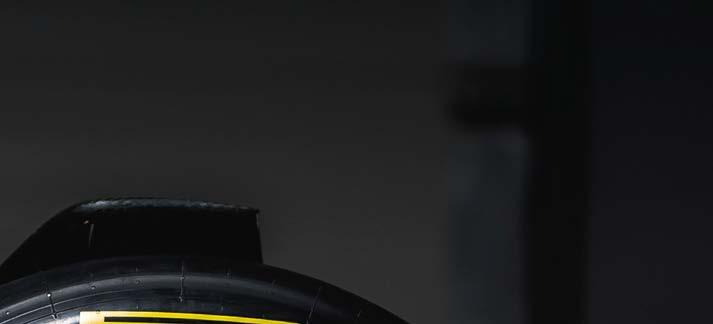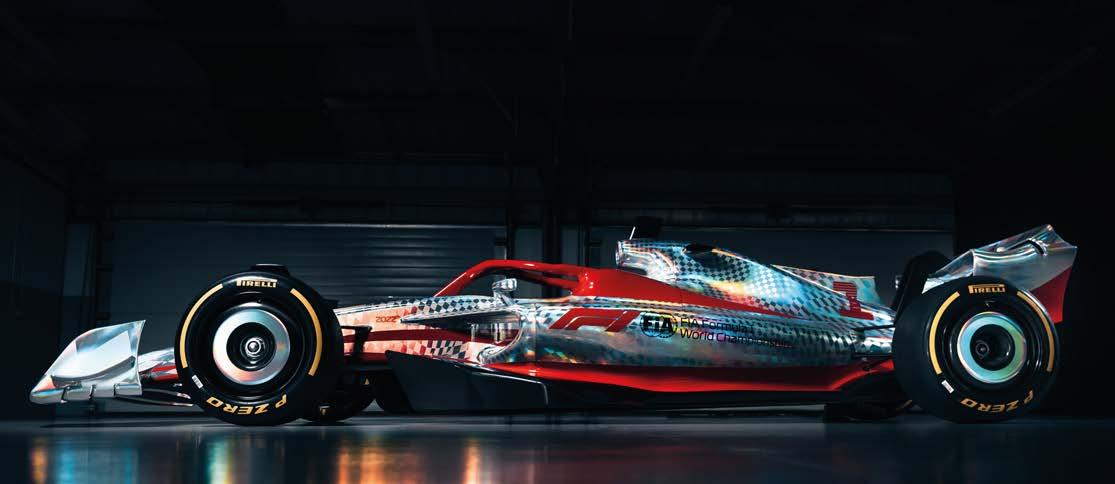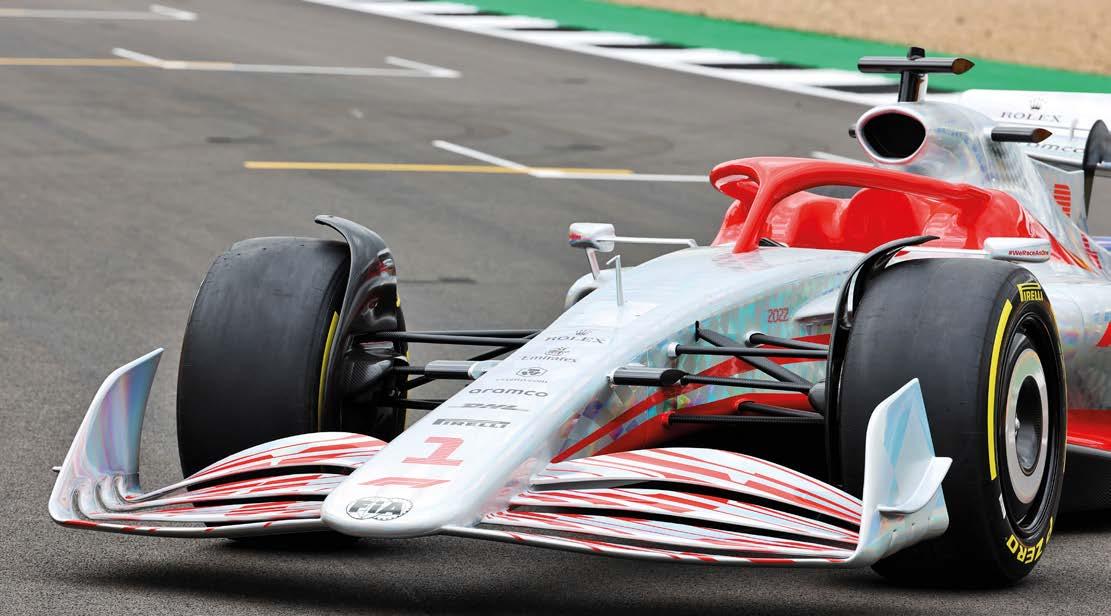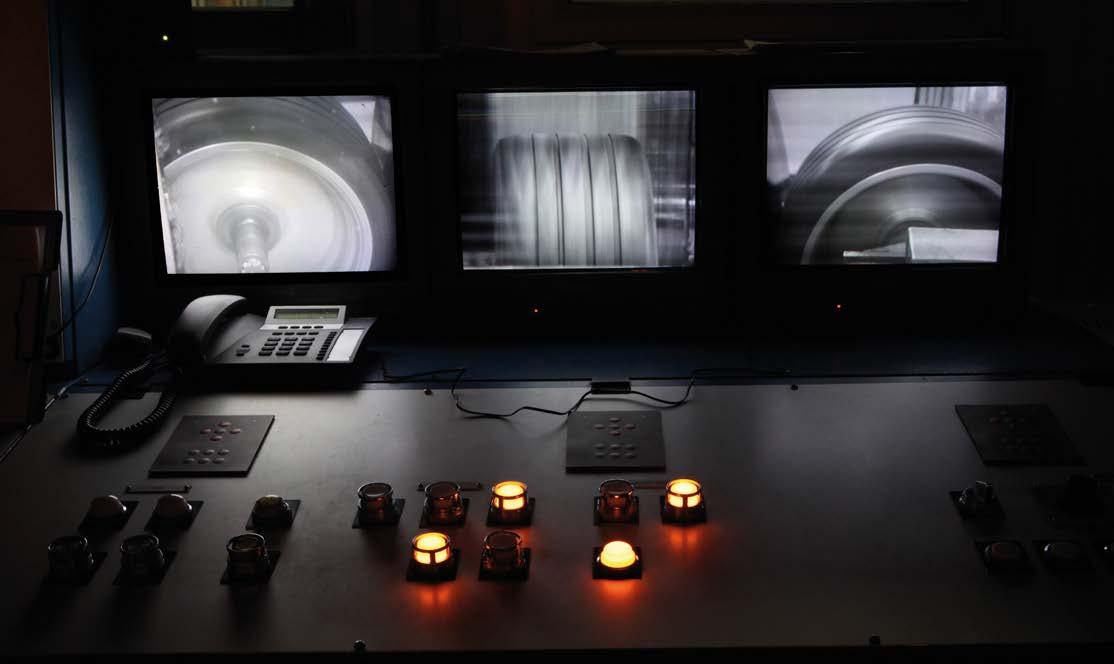
15 minute read
2022 TYRES
Low profile
Formula 1 is fi nally joining the rest of the motorsport world in embracing 18in wheels. Racecar investigates the process of bringing Pirelli’s latest rubber to the track

By Dieter Rencken




Ryan Davis
F1 has used 13in wheels since the 1980s, so the step up to 18in versions of both wheels and tyres is a major technological development, both for the series’ tyre manufacturer and the teams
For irrefutable proof that Formula 1 places road relevance at the very heart of its future technical regulations, look no further than the big black roundels that adorn each corner of a grand prix car. Where for 30 years the aspect ratios of F1’s front and rear tyres had been unchanged at around 75 and 65 respectively, from next season the ratios will reduce dramatically to around half that, give or take a digit or two at each end.
The history of F1 tyre sizes and aspect ratios – the relationship between sidewall height and contact patch width expressed as a percentage – is as complex as it is convoluted. While road car tyres gradually grew in width and reduced in sidewall height, for political and economic reasons F1 doggedly stuck to the 13in wheel sizes originally introduced during the 1980s. Indeed, a case could be made that the F1 trucks that ferry cars and kit have more contemporary tyre ratios.
Rewind to 1985. With Goodyear enjoying an effective monopoly that ran through to 1996, sporadic competition rarely got a look in. The US tyre brand saw no reason to follow road car trends simply to beat itself. When Bridgestone entered F1 in 1997, the Japanese manufacturer suggested lower aspect ratios, only to be rebuffed after Goodyear, afraid of losing its competitive advantage, threatened to leave should the dimensions be changed.
When Goodyear did depart, two seasons later, Bridgestone, now by implication the sole supplier, applied the same arguments, reiterating them when Michelin announced its entry a year later.
After the French company left in 2007, Bridgestone was awarded the first of the FIA’s sole supplier tenders, and simply carried over its rubber through to the end of 2010. Meanwhile, various other series across the globe embraced low profile tyres.
Pirelli replaced the Japanese company in 2011, but so hurried was the process that F1 had no choice but to stick with 13s until finally, with the 2021-’23 tender, both Pirelli and Hankook submitted documents – the former being successful – specifying 18in rims with reduced tyre aspect ratios. At last.
‘New era’ package
The new wheel sizes form an integral part of F1’s ‘new era’ regulation package, which was planned for introduction in 2021, but delays caused by the Covid pandemic pushed the target season out a year. This, in turn, gave Pirelli additional development time, although track testing was temporarily placed on the back burner due to costs and the punishing 2020 schedule after racing resumed last July with 17 rounds in 160 days.
To compensate for Covid delays, Pirelli’s contract was extended by a year. The irony of the latest delay, after so many lost seasons, is not lost on F1’s decision makers. After decades of internal resistance to low-profile tyres, their introduction was disrupted by factors outside the control of the sport.
However, according to a source with knowledge of FIA processes, the decision to switch to low profiles is not as recent as we might think. ‘[It was taken] around five or six years ago in the interests of modernity and a bit more relevance,’ our source says.
Due to the massive implications of the change on car design, it was delayed until a revised technical package was introduced, particularly as teams had (then) been promised regulatory stability on all major components until the end of the 2020 season.
Crucial to the decision was experience of low-profile tyres gained by the FIA from Formula E and World Endurance Championship tyre suppliers, in turn enabling the governing body to formulate a comprehensive specification list. Once the tender had been awarded, discussions with the Italian tyre company opened at FIA Technical Advisory Committee level.
Advantages… include more direct response to steering and braking input, greater control over spring rates… and increased brake disc area, therefore potentially improving stopping power
Advantage 18s
Apart from aesthetics, the advantages of larger rims and lower sidewall heights include more direct response to steering and braking input, greater control over spring rates as the ‘jounce’ of high sidewalls is reduced, and increased brake disc area, therefore potentially improving stopping power. This latter point could potentially see F1 adopt ceramic (or other) braking technologies as it strives to phase out carbon friction materials.
‘Based on Brembo’s strategy and new vision, we are already working on new materials and evolutionary processes in terms of consumption and emissions,’ a spokesperson for the brake company told Racecar Engineering.
‘This is our philosophy, not only because Formula 1 is asking all suppliers to adapt to this new sustainable approach, but because our corporate strategy is to produce materials


The increase in tyre diameter from 660mm to 720mm has broad design implications, as does the greater distance between the brakes and the new wheel rims
that are sustainable for the environment. In Formula 1 this process has started.’
During initial Technical Advisory Committee (TAC) discussions, attended by all teams, FIA, F1 and Pirelli, it was agreed that tyre diameter would increase marginally (from 660mm to 720mm) with rims incorporating (fixed) wheel covers and finger recesses for ease of grip during carry and pitstop activities. Covers displaying graphic information were also considered, but these were pushed out, possibly to 2023.
‘Obviously, [at that stage] there was an idea for F1 to completely change the cars for 2021, but that was postponed to 2022 [due to Covid],’ notes Mario Isola, Pirelli’s head of car racing. ‘The discussion flow started with understanding some parameters in the technical regulations.’
Although these had not at that early stage been finalised, and would not be for another year, Isola says they requested information on expected levels of downforce [and resultant g forces], details on engine torque and power outputs and anticipated maximum speeds.
‘Heat transfer is another important parameter because the spacing between the brakes and the rim is much higher,’ Isola adds. ‘Therefore, we predict there will a lot less heat transfer from the brakes.’
Only once these details had been verified – Isola smiles as he recalls some of the ‘crazy figures’ teams provided during a similar exercise in 2016 ahead of developing a range of wider tyres for 2017 – could Pirelli embark on preparing initial finite element models to design the first ‘virtual’ 18in tyres.
‘We supplied to the teams two different models,’ says Isola. ‘One is a finite element model [FEM], the other is a thermal mechanical model of the tyre, which is what teams use in their simulators, including driverin-the-loop simulators.’
He adds that Pirelli’s FEM data is encrypted. ‘We are the owner of the model and only we know what’s inside, but we update it periodically depending on the feedback we get from the teams,’ he stresses. ‘Sometimes you get feedback from individual teams that is quite different.
‘Then we ask for clarifications. Sometimes they realise that [with their simulations] not everything is perfect, so they adjust their simulations, or we can adjust our model.’
Parallel engineering
According to Pirelli’s R&D chief, Pierangelo Misani, the various processes, from design through prototyping to testing and manufacture, were developed via its F1 engagement, and then adopted by the road car tyre and other divisions. Indeed, he says these techniques enabled the company to remotely develop three different road car tyre ranges during the height of the pandemic, all of which have since been launched.
‘[F1] has enabled us to develop new techniques. If you need a tyre that is so light with less material than the standard one you have to reduce the tolerances. So, I can say the experience in Formula 1 is not purely related to materials, or geometry, or performance, but also to development tools and methods and manufacturing processes.
‘There is not much difference between the development steps to develop Formula 1 tyres and street tyres simply because we use the experience and modelling tools from Formula 1 for both,’ he says.
‘The first step is virtual, then we go to physical [laboratory] testing, but there is a sequence of activities inside both steps.’
However, Misani stresses the profile of the tyre is fundamental. ‘It determines how the tyre will generate forces, both because it’s how you put the contact patch on the ground, but also how the forces generated are then transmitted to the rim, and then to the car, by what we call the ‘ply line’.
‘According to the geometry of this carcass, you have a quite different behaviour. When you move to 18in, you will typically realise a faster response [due primarily to less sidewall flex] than with 13in.’
The final profile is also crucial to the entire process as it dictates the moulds that are required for batch production of the prototype tyres used for both laboratory and
Mario Isola, head of car racing at Pirelli

The new tyres started as finite element models and only became reality when approved by the FIA and teams
These were then tested in the lab for integrity and performance, and on track on the so-called ‘mule’ cars

track testing. Get the shape wrong and it’s back to square one, whereas the materials used for actual carcass construction and compound ingredients can be fine tuned later on in the process.
Validation process
‘We started to design a couple of different profiles, then the next step was to validate the profile,’ explains Isola, adding that the selected profile is squarer than on current tyres due to the smaller, stiffer sidewall.
‘We start from the models, then we prepare some physical prototypes, which are tested indoors [on high-speed rigs]. We have several different tests for integrity and for performance. The final validation is on track.
‘To validate the profile we asked, and [FIA, F1 and the teams] agreed, to start testing [on the so-called ‘mule’ cars, adapted from 2018 cars to replicate ride height, downforce and car mass] in September 2019. That way we had the possibility to freeze the profile, and then start 2020 focussing our attention on construction and compounds.’
All was running to schedule at that point. Four teams had completed ‘dry’ tests, but then along came Covid, which brought the entire process to an immediate and inconvenient halt for around two months as all the teams went on a total, FIA-enforced shut down during April and May 2020.
In the interim, Pirelli continued with its indoor test programme at its Milan R&D base using tyres produced in batches of 10 by its F1 plant in Slatina, Romania and trucked overland to Italy. As an aside, Pirelli has replicated the F1 tyre production line at its Izmit, Turkey facility, just in case the Romanian plant is hit by a natural, or other, disaster.
Once the worst of the pandemic had blown over and F1 operations returned closer to normal in the early part of 2021, track testing resumed, with nine of 10 teams having committed to 2021 after expressions of interest were called for in August last year. Williams is still considering its options after being unable to confirm participation during its sale process to Dorilton Capital, which occurred just as the deadline loomed.
Even multiple World Champion, Lewis Hamilton, who usually shuns testing, offered his services during his Mercedes team’s programme at Imola after the Emilia Romagna Grand Prix in April in 2021.
‘It’s probably one of the first [test days] I have ever volunteered for,’ he said afterwards. ‘So I immediately regretted it when I woke up in the morning on the day!
‘It was a really great track to test at, though, and the weather was good, so I enjoyed it. I plan to be [in F1] next year [he said at the time] and want to be a part of it, so I want to help Pirelli towards having a better product. It’s important for me to gauge what the starting point is, and what differences I can help with, so that from a driver point of view we have more mechanical grip from the tyres and less degradation. It was a good test, and though obviously it was only the first step with the new tyres, it definitely wasn’t a bad place to start.’
Isola was equally upbeat after the Imola test. ‘It provided us [Pirelli] with a result that was coherent across different cars and across different circuits,’ he said. ‘We had the possibility to validate different constructions, starting from Jerez to Bahrain, Imola and we are now in a situation where I would say the construction is almost finalised. [Next] we start a test campaign on compounds.’
As part of the programme, all tyre-specific data is shared with all teams, and then updated on an as-and-when basis.
Weight watchers
‘We’ve had feedback lap times and basic information from each test, with technical bulletins coming through from Pirelli,’ confirms Alpha Tauri technical director, Jody Egginton. ‘We’ve done a lot of simulation work with the model [of] the tyre, so we understand what it’s going to do, and we’ve got a good grip in vehicle dynamics terms.’

Although Covid delayed on-track testing, Pirelli continued its indoor test programme at its R&D facility in Milan, fine tuning the compounds that will be used
He also makes a point about a rather hefty elephant in the F1 paddock: ‘We’ve got a big increase in tyre and wheel mass, plus we’re not allowed to run inerters [from next year].’
The latest calculations suggest car mass will rise by 14kg, due to heavier wheel / rim assemblies, split approximately 3kg per front wheel and 4kg for each rear wheel. The reason is simple: for a given circumference, with low profile tyres, alloy largely displaces air and lightweight rubber.
Seven of the 10 scheduled 2021 tests, comprising a mix of dry, intermediate and wet running, had been completed at time of writing. Two further dry tests were subsequently planned for after the British and Hungarian Grands Prix respectively, with a final wet fling listed for Paul Ricard in France mid-September. After that, all 10 teams are expected to attend a composite test in Abu Dhabi after the final race of the season.
By that point the teams will be in the thick of manufacturing their new era car designs, having based concepts on a combination of data obtained from wind tunnel studies, simulations and CFD calculations. In each instance, input from Pirelli is crucial to the process, in particular tyre modelling data and 60 per cent scale wind tunnel tyres, which accurately simulate tyre behaviour at speed.
The latter, produced in a dedicated Pirelli studio in Rome, are a particular challenge as tyres make up approximately a third of frontal area, while spinning at enormous speeds. The resultant wake affects airflow across the car, while steered tyres deform in compression, yaw and pitch, causing changes in sidewall and contact patch shape. An aerodynamicist’s nightmare, in other words, unless the wind tunnel tyres are spot on.
The 2022 challenge
For teams, however, the biggest challenge is yet to come – translating the tyre test data into sustainable on-track performance, as Ferrari racing director, Laurent Mekies, notes: ‘2022 will bring three massive pillars that are entirely new. Completely different aerodynamic regulations, different ways to operate the car [due to revised sporting regulations] and mechanical suspension, which nobody has had for 10 or 15 years. So, a lot of different limitations and, in the middle of those, how to ‘switch on’ the completely new tyres. I think that will be the big challenge.
‘There will be a huge amount of discovery with the 18in [wheels and tyres]. It’s a great challenge as a team to make sure we have the base to get the core understanding we need.
‘It will be a steep learning curve, but in two years we will look back at the starting point and wonder what we were doing at the time.’
Although Mekies does not foresee the switch to 18in wheels alone resulting in major changes to the competitive order, he does see it as a contributory factor, when taken in conjunction with the ‘pillars’ listed above.
‘I think it will be a combination of the concepts, the new regulations, how they interact with the tyres and how you make everything work,’ he says. ‘We have the potential to see a surprise from the midfield teams. It’s risk and opportunity for everybody.’
All parties agree that the amount of research that has gone into the 2022 regulations by far exceeds what has gone before, whether at FIA, F1 or team level, while Pirelli has been afforded a longer timeframe than at any previous stage in its 10-year F1 history. Indeed, longer than any tyre supplier has ever been given, with the pandemic only widening that development window.
Come the 2022 season opener – probably in Bahrain, after even more warm weather tests on the desert island – the big black roundels that adorn each corner of a grand prix car will not only represent arguably the single biggest visual indicator of F1’s ‘new era’, but the biggest advance in Formula 1 tyre technology since the sport adopted radial ply tyres in the 1970s. That is how radical the new 18in tyres are in F1 terms.







